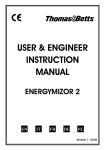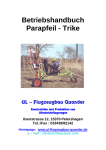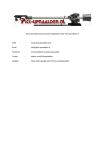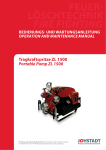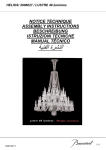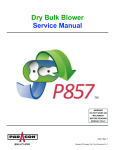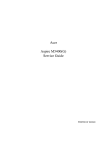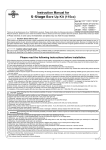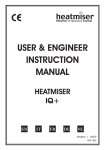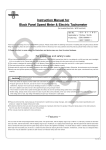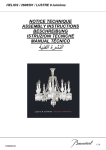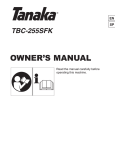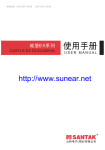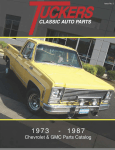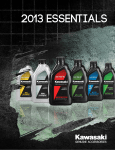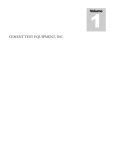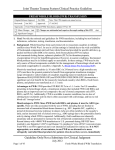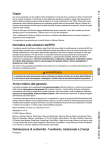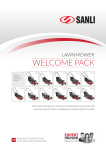Download 3202-03_BDA_komplett_engl __12 09 07
Transcript
Göbler-Hirthmotoren KG Service manual Engine 3202/03 Göbler-Hirthmotoren KG, Max-Eyth-Str. 10, D-71726 Benningen, Germany Tel.: 0049-7144-8551-0, Fax: 0049-7144-5415 e-mail: [email protected], internet: www.hirth-engines.de 3202-03_BDA_komplett_engl _(12 09 07).doc 2008-05-19 Engine Type 3202/03 Manual Read the operating instructions completely before the assembly of the engine or before starting the engine. In the interest of the ongoing developments of our products, we reserve the right to change the delivery volume in form, technique and supply. We also ask for your understanding that the data in this instruction manual gives no further claims. 3202-03_BDA_komplett_engl _(12 09 07).doc 2008-05-19 Table of Contents Chapter Topic Page 1 Description of the engine, its systems, and 1-1 essential technical information 1.1 Overview of the engine 1-1 1.1.1 Model 3202/03 1-1 1.1.2 Description of the carburetion system 1-2 1.1.3 Description of the ignition system 1-2 1.1.4 Description of the cooling system 1-4 1.2 Installation 1-4 1.2.1 Mounting and securing the engine 1-4 1.2.2 Airflow to the engine 1-5 1.2.3 Fuel system layout 1-5 1.2.4 Adjusting the carburetors 1-6 1.2.5 Securing spark plug caps: Inverted installation 1-6 1.2.6 Disconnecting ignition system 1-6 1.3 Engine instruments 1-7 1.3.1 Cylinder head temperatures 1-7 1.3.2 Exhaust gas temperature 1-7 1.3.3 Fuel pressure 1-8 1.4 Identification plate 1-8 1.5 Technical data 1-9 1.6 Installation sketch 1-9 2 Operating the engine 2-1 2.1 General guidelines 2-1 2.2 Engine break in 2-1 2.3 Starting procedures 2-2 2.4 Operating conditions 2-3 2.5 Engine shutdown 2-3 3202-03_BDA_komplett_engl _(12 09 07).doc 2008-05-19 3 Maintenance 3-1 3.1 General 3-1 3.1.1 Scope 3-1 3.1.2 Common and special tools and initial torque values 3-1 3.2 Service intervals 3-2 3.2.1 Daily inspections 3-2 3.2.2 Periodic inspections 3-2 3.3 Replacement parts 3-2 3.4 Maintenance procedures 3-3 3.4.1 Carburetor 3-3 3.4.1.1 Synchronization of carburetors 3-3 3.4.1.2 Setting the fuel mixture adjustment screws 3-3 3.4.1.3 Cleaning the carburetors 3-4 3.4.2. Air filter 3-4 3.4.2.1 Removal and installation of air filters 3-4 3.4.2.2 Cleaning the air filters 3-4 3.4.3 Fuel and pulse lines 3-4 3.4.3.1 Inspection of fuel line 3-4 3.4.3.2 Inspection of pulse line 3-4 3.4.4 Spark plugs and spark plug caps 3-4 3.4.4.1 Checking spark plug caps 3-4 3.4.4.2 Spark plug installation and removal 3-5 3.4.4.3 Condition of spark plugs 3-5 3.4.5 Fan 3-5 3.4.5.1 Removal and installation of cooling system 3-5 3.4.5.2 Removal and installation of fan housing 3-5 3.4.5.3 Changing the fan belt 3-5 3.4.6 Cylinder head 3-6 3.4.6.1 Removal and installation of cylinder head 3-6 3.4.6.2 Checking cylinder head conditions 3-6 3.7 Trouble shooting 3-6 3.7.1 Engine will not start, or is very difficult to start 3-6 3.7.2 Engine will not come up to idle speed 3-7 3.7.3 Engine runs rough, uneven and with insufficient ... 3-7 3202-03_BDA_komplett_engl _(12 09 07).doc 2008-05-19 3.7.4 Engine does not develop full power 3-7 3.7.5 Excessive cylinder head temperature 3-8 4. Ignition system wiring diagrams 4-1 4.1 Single ignition wiring diagram 4-2 4.2 Dual ignition wiring diagram 4-3 3202-03_BDA_komplett_engl _(12 09 07).doc 2008-05-19 Chapter 1 Description of the Engine, Its Systems, and Essential Technical Data 1.1 Overview 1.1.1 Model 3202/03 The Hirth 3202 and 3203 engine (Illus. 1.1.1-1), from Göbler-Hirth Engines Ltd., is a fancooled, side-regulated, two cylinder inline, two stroke engine. The cylinders consist of an aluminum alloy coated with an abrasion-resistant surface. The cylinders are attached to the crankcase with bolts, washers and hexagonal nuts. The cylinder heads consist of a special non-melting aluminum alloy, which resists high temperature with an even hardness. They are fastened to the cylinder without any sealant, using cylinder bolts and washers . The pistons consist of an aluminum alloy and are packed with two piston rings against the cylinder surface. The piston is connected to a piston rod with a gudgeon pin and needle roller bearing. The crankshaft is made of Chromoly steel (42CrMo4) and is positioned in five grooved ball bearings. It is a constructed crankshaft in which the individual parts are pressed together to form the complete crankshaft. Two grooved ball bearings are attached on the power take off side, two more between the crank control handle, and one on the ignition side. The power take off is cone-shaped and has a centric coil in order to wind a connecting cone onto the power take off side. The piston rods are connected to the crankshaft with crank pins and needle roller bearings. The crankcase consists of an aluminum alloy. It is constructed as an axial divided case and consists of a lower and an upper part. It is held together by seven cylinder bolts with safety washers, and in addition by the eight fastening bolts of the cylinders. On the ignition side, it includes the statorplate of the ignition and is constructed so the the fan housing can be mounted over it. Illustration 1.1.1-1 (Engine 3203V) 3202-03_BDA_komplett_engl _(12 09 07).doc 2008-05-19 1.1.2 Description of the Carburetion System The fuel mixture system (Illus. 1.1.2-1) of the 3202 and 3203 engine consists of two Dell’Orto sliding carburetors. The carburettors are mounted with rubber flanges on the left side of the crankcase by means of diaphragm valves. On the intake side of the carburettors are two dry-airfilters, which are mounted on the carburettors with hose clamps. The carburetor is thermally insulated by a piece of insulation. The hot cool air stream exiting from the intake socket is kept apart from the carburetor by shield in the intake socket. Illustration 1.1.2-1 (Fuel Mixture [or Carburetion] System) 1.1.3 Description of the Ignition System The ignition system (Illus. 1.1.3-1, 1.1.3-2) consists of an armature plate, a magneto , an EBox, two ignition coils and the ignition cables with spark plug caps. The ignition is entirely electronic and has an E-PROM (?) for a free programmable electro-dynamo-magnetic ignition. There is generator power for electric uses during operation and for charging the battery. The ignition system is operational with single as well as double ignition. The armature is fastened to the crankcase on the ignition side. The magneto is situated on the crankshaft and encloses the armature plate. The fan housing shields the magneto wheel of the ignition. On the fan housing is the E-Box and the ignition coils on an ignition coil fastener. 3202-03_BDA_komplett_engl _(12 09 07).doc 2008-05-19 Illustration 1.1.3-1 (Single Ignition) Illustration 1.1.3-2 (Dual Ignition) Illustration 1.1.3-3 (View of the ignition side with installed ignition system) 3202-03_BDA_komplett_engl _(12 09 07).doc 2008-05-19 1.1.4 Description of the Cooling System The 3202 and 3203 engine has a mechanically operated forced air cooling which is transposed on the exhaust side and fixed on the ignition side. (Illus. 1.1.4-1). The fan is mounted inside the fan housing by a cam . It is propelled by a flat belt and a catch, which is attached to the magneto wheel of the ignition. The cool air flow, built up by the fan, is divided over the two cylinders for maximum cooling through the fan shroud surrounding the two cylinders. The hot cool air flow is blown off into the surroundings on the intake side. Air buffling cowl Fan housing Illustration 1.1.4-1 (View of the Fan Housing and the Shroud) 1.2 Installation Instructions 1.2.1 Mounting and Securing the Engine The four threaded sockets (UNC- ½“) for mounting the 3202 and 3203 engine (Illus. 1.2.1-1) are located on the underside of the crankcase. Illus. 1.2.1-1 (Engine Mounting Sockets ) 3202-03_BDA_komplett_engl _(12 09 07).doc 2008-05-19 The engine should be mounted so that the moment transmitted from the engine to the mount can be on the broadest base as possible [?]. The shock mounts used should be as stiff as possible, because the engine vibration can result in a mounting that is not secure. This leads to problems with the fuel mixture (i.e. foaming of the fuel, uncontrolled flapping of the fuel pump membrane) and with that to unsafe operation of the engine. -Recommendation: The engine is bolted to a plate which is about twice the size as the underside of the engine (the wider the better). On the two outsides of the plates, there should be six or more rubber dampeners, three on each side, in line. This entire assembly will be fastened through the rubber dampener elements onto another plate which in turn is tightly connected to the apparatus. 1.2.2 Airflow to the Engine The engine has to be installed in such a way that the fresh air stream supplied is sufficient to insure its cooling and adequate for the supply of air to the carburetor. For a cowled installation it is necessary to take care that the outgoing hot cool air stream is not allowed into the carburetors, since that will lead to a drastic reduction in performance. At the same time, the outgoing hot cool air stream must be able to exit the cowling without blockage, since this will force the engine to overheat and lead to its destruction. The engine's forced air cooling system is designed so that if enough fresh air flows in, the satisfactory cooling of the engine is insured in any type of operation. No changes may be made in the cooling system. It is absolutely imperative to have a sufficient supply of fresh air. 1.2.3 Fuel System Layout The fuel supply of the engine is supported by a diaphragm pump (Illus. 1.2.3-1), operated by pressure from the crankcase. Illustration 1.2.3-1 (Diaphragm Fuel Pump) Impuls connection 3202-03_BDA_komplett_engl _(12 09 07).doc 2008-05-19 This fuel pump is situated in the fuel line between the fuel tank and carburetor. A fuel filter should always be installed between the diaphragm pump and fuel tank. The diaphragm pump should be installed at a place with the least influence of vibration or heat. Take care to insure that, with an upright installation of the diaphragm pump, the fuel exit is on top. The placement of the connecting pieces can be recognized by arrows on the casing. The central connection of the fuel pump is the impulse connector. The impulse line from the crank case to the diaphragm pump should be as short as possible, straight and inclining toward the diaphragm pump. When choosing the impulse line and the fuel line, take care to use rigid lines, which do not expand under pressure. The impulse line should not exceed a maximum length of 150 mm and a minimum inside radius of 6 mm. In any case it is advantageous to position the fuel tank above the engine, since this ensures a certain pressure to the fuel supply. In addition, however, it is recommended to use the diaphragm fuel pump. The fuel pressure should be checked with an appropriate measuring instrument in any event. When installing the fuel tank underneath the engine, the following geometric data must be noted. The maximum length of the suction line between fuel tank and membrane line should not exceed 2000 mm with a minimum inside radius of 6 mm. The maximum suction height must not exceed 1 m. It is necessary to keep in mind the possible incline of the finished product (climb and descent with flying machines, up and down hills with ground vehicles). The maximum length of the pressure line should be no longer than 500 mm, with minimum inside radius of 6 mm. Do not exceed the maximum pressure between the center of the diaphragm pump and the center of the carburetor float housing. In case the diaphragm pump is added on to the engine, it has to be installed vertical to the crankshaft axis (power take off to ignition side). This guarantees that vibrations coming from the engine around the crankshaft axis do not impede the actions and function of the diaphragm pump with conflicting vibrations. 1.2.4 Adjusting the Carburetors Adjustment of the slide on the dual carburetors is accomplished by Bowden cables . It is best to route the two cables to a single point with a Y-fitting. If possible, both cables should have the same length between the Y-fitting and the carburetors. At idle (both slides sit on the idle stop screw), there should be some play so that the slide can securely reach the idle position. It is absolutely necessary to take care that both slides of the carburetors move simultaneously. The idle position of the slides must be the same with both carburetors. In order to accomplish this, the slides must be brought on the same level in the idle position, using the idle stop screws (measure and adjust the opening height of both slides to the same level). When pulling the slides open, they should both be synchronized to lift off from the adjustment screws at the same time to open the passage. 1.2.5 Securing the Spark Plug Caps: Inverted Installation If the engine is installed in an inverted position, the spark plug caps must be secured in such a way to prevent interruption or breaking of contact through vibration of the engine (Secure with safety wire). 3202-03_BDA_komplett_engl _(12 09 07).doc 2008-05-19 1.2.6 Disconnecting Ignition System Both circuit breakers must absolutely be installed to separate multiple switches. These instructions must absolutely be followed, since combining the two multiple cables to one switch, will cause one circuit to drop out. 1.3 Engine instruments It is urgently recommended that the cylinder head temperature, the exhaust gas temperature, and the fuel pressure be monitored. Proper adjustment of the engine guarantees its trouble free functioning under the prescribed installation conditions. When engine installation is not carried out by Göbler-Hirth Engines, there are sometimes problems, such as insufficient flow of cool air, a fuel tank installed too low for ascending and descending flight/uphill and downhill driving, and it is absolutely necessary for secure engine operation that the cylinder head temperature, exhaust gas temperature, and fuel pressure be monitored. The table below lists items which can be ordered from Göbler-Hirth Engines Ltd. Table 1.3-1 Designation Exhaust Gas Temperature Gague Cylinder Head Temperature Gague Fuel Pressure Gague Tachometer Digital Combination Instrument (EIS) Order Number 029.30 029.31(SI), 029.32 (DI) 029.20 / 029.21 029.18 029.22 1.3.1 Cylinder Head Temperature Cylinder head temperature (see Table 1.5-1) is measured at the spark plug. A ring-shaped thermal element placed under the spark plug is screwed in with it. The placement of the thermal element is of great importance. The connecting cable of the thermal element should be led upward behind the spark plug in such a way that the cool air stream does not blow on the connection of the ring-shaped sensor . Only calibrated sensor devices should be used. Notice that measuring cables that have later been made longer between the thermal element and the measuring device may falsify the reading. Temperature measuring devices with lengthened cables have to be recalibrated at time of installation. Defective or improperly working thermal elements, temperature gagues, and measuring cables have to be replaced immediately. The maximum acceptable cylinder head temperatures mentioned by Göbler-Hirth Engines are based upon the proper positioning and calibration of the measuring devices within the range of these temperatures. 3202-03_BDA_komplett_engl _(12 09 07).doc 2008-05-19 1.3.2 Exhaust Gas Temperature The exhaust gas temperature (see Table 1.5-1) is measured individually for each cylinder at the exhaust bend [manifold]. An exhaust bend which is prepared for installation of thermal elements may be ordered from Göbler-Hirth Engines. A staff-shaped thermal element will be pressed into a special sealing screw joint. Of great importance is the installation position of the thermal element. The thermal element must be pushed into the exhaust bend deep enough so that its point is in the middle of the exhaust bend pipe [manifold]. Only calibrated measuring devices should be used. Notice that measuring cables that have later been made longer between the thermal element and the measuring device may falsify the reading. Temperature measuring devices with lengthened cables have to be recalibrated at time of installation. Defective or improperly working thermal elements, temperature gagues, and measuring cables have to be replaced immediately. The maximum acceptable exhaust gas temperatures mentioned by Göbler-Hirth Engines are based upon the proper positioning and calibration of the measuring devices within the range of these temperatures 1.3.3 Fuel Pressure (see Table 1.5-1) 1.4 Identification Plate The identification plate is on the intake side, upper side of the crankcase. Illustration 1.4-1 (Identification Plate Position) 3202-03_BDA_komplett_engl _(12 09 07).doc 2008-05-19 1.5 Technical Data Table 1.5-1 Manufacturer Model Type [lit. Work process] Number of Cylinders Displacement Stroke Bore Compression Ratio Performance Maximum engine speed Direction of rotation Starter Ignition System Generator Spark Plugs (single ignition) Spark Plugs (dual ignition) Ignition timing Carburetion [fuel mixing system] Type: Main jet: Jet needle: Needle jet: Idle jet: Cooling Mixture Fuel 2-stroke oil Cylinder head temperature, max. Exhaust gas temperature, max. Fuel pressure, minimum Engine weight without muffler Muffler weight Göbler-Hirth Engines Ltd. 3202/3203 Two stroke 2, in line 626 cm3 69 mm (2,72 in) 76 mm (2,99 in) 9.5 : 1 3202: 40,4 kW (55PS) 3203: 47,8 kW (65 PS) at 5500/min at 6300/min 6500 RPM Left, as seen from PTO side [geared prop turns to right] Electric start and/or recoil starter Electronic dynamo magneto ignition, single or dual 250 W, 12 V 023.29, 023.32 (PP), BR8HS (NGK), W24FSRU (ND) 023.28, 023.35 (PP), CR8HSA, U24FSR-U (ND) 18° BTDC (at 2000 RPM) 3202: 3203: 2 DellOrto PHBP 34 BS/BD7, 2 DellOrto PHBP 34BS/BD8 168 160 K 35/2 K 35/2 AB 268 AB 268 40 40 2 air filters (dry) 2 air filters (dry) Air cooled by axial blower turned by a flat belt 1 : 50 (2%) (1:100 with BlueMax oil) Premium lead free, 95 Octane Good quality 2-stroke oil for hot (air-cooled) engines 280° C / 536°F 680° C / 1256°F 0.3 bar 31 kg / 70.88 lbs 6 kg / 7.33 lbs 3202-03_BDA_komplett_engl _(12 09 07).doc 2008-05-19 1.6 Installation sketch 223 208 383 450 96 1/2"-13U N C 31 36 24 36 210 377 3202-03_BDA_komplett_engl _(12 09 07).doc 2008-05-19 112 56 Chapter 2 Operating the Engine 2.1 General Guidelines It is absolutely necessary to follow the instructions in this chapter in order to achieve longterm, economical, and satisfactory service from the engine. - - USE ONLY THE PRESCRIBED TYPE OF TWO STROKE OIL AND THE PROPER GRADE OF GASOLINE. INSURE THAT FUEL IS MIXED IN THE CORRECT GAS/OIL RATIO . REMOVE THE FUEL FROM THE CARBURETOR BOWLS AND GAS TANK WHENEVER THE ENGINE IS NOT GOING TO BE USED FOR AN EXTENDED PERIOD. AFTER A LONG STANDDOWN, REMOVE ANY LEFTOVER FUEL IN CARBURETOR BOWLS AND GAS TANK BEFORE OPERATING THE ENGINE. TAKE CARE THAT THE AIR CIRCULATION IS SUFFICIENT TO COOL THE ENGINE AND SUPPLY THE CARBURETORS. INSURE THAT THERE IS NO OBSTRUCTION THAT CAN IMPEDE THE EXIT OF HOT AIR. BE SURE THAT HEATED AIR IS NOT SUCKED INTO THE CARBURETORS. USE ONLY RESISTOR TYPE SPARK PLUGS AND RESISTOR PLUG CAPS. EVERY TIME A WARM UP PHASE BEFORE RUNNING THE ENGINE UNDER LOAD 2.2 Break In Procedures Hirth engines have no explicit break in procedures, since the Nikasil coating of the cylinders and the Aluminium pistons do not have to adjust to each other. The engines are sealed from the time of their assembly in accordance with the maximum temperatures prescribed in Chapter 1 for cylinder heads and exhaust gas. After the first 10 – 15 hours in service or after a major inspection, the following tasks should be accomplished for safety reasons: - tighten engine mount bolts tighten cylinder head bolts tighten spark plugs check for leaks, loose nuts and bolts 3202-03_BDA_komplett_engl _(12 09 07).doc 2008-05-19 Attention ! For safety reasons, it is recommended that the following items be checked each time before operating the engine: - Starter (check connections, installation, and condition; correct if necessary) Carburetor (check connections, installation, and condition; correct if necessary) Ignition (check connections, installation, and condition; correct if necessary)) Fan (check installation and condition; check condition and tension of fan belt; correct if necessary) Cylinder heads (check installation and condition; correct if necessary) Cylinders (check installation and condition; correct if necessary ) Exhaust manifold (check installation and condition; correct any discrepancy) Muffler (check installation and condition; correct any discrepancy) Spark plugs and plug caps (check installation and condition; replace if necessary) Fuel system (check for leaks and dirt in filters; repair or change, as necessary) 2.3 Starting Procedure Fuel supply (insure tank is full and fuel valve is open) Use choke if engine is cold, but not if engine is warm or hot. Set throttle at idle (carburetor slide should also be at idle position) Close ignition circuit (Turn ignition switch to ON-Position ) Start engine (use starter for maximum of 10 seconds) [10 s?] If the cold engine will take the gas, the choke can be retarded (check by advancing throttle lightly) 7. Allow engine to warm up for 3 minutes at 1/4 power (ca. 3000 rpm). 8. When it reaches operating temperature, engine is ready to go. 1. 2. 3. 4. 5. 6. Notice: If the engine is or should be later equipped with a centrifugal clutch, the following procedure must be observed: 1. Warm up the engine with enough RPM to keep centrifugal clutch fully engaged. 2. Accomplish the warm up phase without allowing clutch to disengage. If engine revolutions are very low, with clutch not engaged, the warm up will take longer. Attention ! If the warm up or other engine operation is carried out in the range where the clutch engages, the result may be increased wear on the surface, glazing of the coating, or overheating of the clutch. 3202-03_BDA_komplett_engl _(12 09 07).doc 2008-05-19 2.4 Operating Conditions of the Engine During operation of the engine, it is necessary to monitor the cylinder head and exhaust gas temperatures of both cylinders. So long as the maximum-allowed cylinder head- or exhaust gas- temperatures are not exceeded, the engine can be operated at the selected power setting (including maximum power) without any time limitation. Furthermore, it is recommended that fuel pressure be monitored during engine operation. Insufficient fuel pressure can lead to loss of performance and cause the engine to miss. 2.5 Engine Shutdown Before turning the engine off, it should be run at idle power for one minute. Because of the fan operation, the cylinder head temperature should go down. This procedure should always be followed, since an engine turned off right after operating at high speed has a tendency to overheat. 3202-03_BDA_komplett_engl _(12 09 07).doc 2008-05-19 Chapter 3 Maintenance 3.1 General 3.1.1 Scope This chapter contains the necessary instructions for technically qualified personnel to carry out minor inspections and repairs, such as: - Periodic inspections of the engine Maintenance of engine components Trouble shooting 3.1.2 Tools and Special Tools and Initial Torque Values The specifications and sizes of tools are given according to the metric system and can be procured commercially in specialty shops. Tools: (metric tools) Type Open-end wrench Open-end wrench Hexagonal socket wrench Hexagonal socket wrench Sparkplug wrench Torque wrench Size 7 10 3 5 [no size given] 0 – 100 Nm Type Open-end wrench Open-end wrench Hexagonal socket wrench Hexagonal socket wrench Sparkplug wrench Size 8 13 4 6 20.6/20.8 Special tools can be procured commercially, from Göbler-Hirth Engines Ltd. , under specific G.-H. numbers Spezialwerkzeuge: Type Flywheel puller Piston ring clamp (cylinder mounting) GH-number W 138 W 108/15 Initial Torque Values Type M4 x ... M6 x ... M16 x ... Initial Torque 2,8 - 3,3 Nm 9 – 11 Nm 150 Nm Type M5 x ... M8 x ... Spark plug 3202-03_BDA_komplett_engl _(12 09 07).doc 2008-05-19 Initial Torque 4 - 4,4 Nm 23 - 28 Nm 16 Nm 3.2 Service Intervals 3.2.1 Daily Inspections Before operating the engine, a thorough daily inspection should be carried out. Observe the following points: 1. 2. 3. 4. 5. 6. 7. 8. 9. Air filter - check condition and installation Starter - check condition and installation Ignition system - check condition, fastening, and connections Fan housing - check condition and installation Fan - check condition and fastening Fan belt - check condition and belt tension Cowling - check overall condition and the fasteners Crank case and cylinders - check for leaks overall condition of installation Spark plug caps - check condition and the connections 3.2.2 Periodic Inspections Inspection interval Cooling Airway: check for free flow and freedom from pollutants Baffles: check for damage and cracks Carburetor Air filter: clean Carburetor adjustments: check Carburetor: clean Fuel system Fuel filter: clean Fuel lines and connections: check Impulse line [to the membrane pump]: check Spark plugs Clean spark plugs Check gap of electrodes Exhaust system Check for damage and tight fit Check exhaust pipe for residue 25 h 100 h 500 h X X X X X X X X X X X X X X X X X X X X X X X X X X X X X X X X X X X 3.3 Replacement Parts The parts listed in Table 3.3-1 should definitely be replaced after the specified number of hours of operation. If signs of excessive wear appear before then, that particular part should be replaced at that time. 3202-03_BDA_komplett_engl _(12 09 07).doc 2008-05-19 Table 3.3-1 The abbreviation "S" means single ignition and "D" represents dual ignition. Number 2 4 2 4 2 1 2 2 2 2 2 Part Spark plug S Spark plug D Spark plug cap Spark plug cap Piston set Crankshaft Cylinder head S Cylinder head D Cylinder Carburetor Air filter Order Number 023.29 023.28 024.22 024.22 014.81 271 BC 322 B2 + 322 H3 272 AW2 + 322 G3 322 A1 + 322 E1 PHBE34BD2/BD3 066.16 Hours in service 50 50 100 100 1000 1000 1000 1000 1000 1000 100 3.4 Maintenance Procedures 3.4.1 Carburetor The carburetors of Hirth engines are jetted in such a way by the manufacturer that the engine is guaranteed to run thermally secure. Since interference with the jetting of the carburetors may lead to overheating, and thus to the destruction of the engine, such interference must be avoided. Only original replacement parts should be used. Data concerning carburetor mounting can be obtained from Göbler-Hirth Engines. Give carburetor specifications, which are marked at the solder joint of the carburetor intake. 3.4.1.1 Synchronization of Carburetors In order to insure even performance and a smooth running engine, both carburetors have to be synchronized precisely. Note that the idle adjustment screw holds the slide in the same position on both carburetors. Measure and adjust the opening height on both carburetors for this. The two cables which move the slide in the carburetor usually come together in a Y fitting leading to a single throttle cable. The cables between the Y fitting and the carburetors need to be adjusted so that there is some play in the cable at the idle position. This will insure the proper idle position of the slides. When the throttle cable is pulled, the slides of the carburetors should move upward simultaneously from the idle position. Lubricate cables if difficult to operate. Defective or frayed cables have to be exchanged for new ones immediately. Bent cable must be changed immediately. 3.4.1.2 Setting the Fuel Mixture Adjustment Screw In both carburetors, the idle mixture adjustment screw is opened half a turn as its normal setting. For this, first carefully turn the screw to closed position, then open it one half turn. 3202-03_BDA_komplett_engl _(12 09 07).doc 2008-05-19 3.4.1.3 Cleaning the Carburetors Turn off fuel switch before cleaning carburetors. Open the aluminium nut which holds the float chamber against the carburetor. Move float chamber downward carefully since it is filled with fuel. Remove the fuel from float chamber along with any debris. Should debris be in float chamber, the fuel filter in the intake line between tank and fuel pump should be checked and, if necessary, replaced. Screw out the main jet from the mixing tube and check for damage or grime. Replace immediately if damaged; clean with gasoline if dirty, then blow out with compressed air. Never push a sharp object through the main jet as that will destroy it. Reassemble in logical reverse order. When putting the float chamber back on, insure that the bolts are properly seated. Torn and/or frayed gaskets must be exchanged immediately for original replacement gaskets. 3.4.2 Air Filter 3.4.2.1 Removal and Installation of Air Filters To remove the air filter, loosen the clamp with a screw driver and pull the filter free from the carburetor flange. To install the air filter, put it on the carburetor flange and fasten it back with the clamp. 3.4.2.2 Cleaning the Air filters Wash the air filter in gasoline and then dry by using compressed air to blow out from the inside to the outside. Check filter for damage and if necessary replace it. 3.4.3 Fuel and Pulse Lines 3.4.3.1 Inspection of Fuel Lines Check the fuel lines between the fuel pump, carburetors, and fuel tank for leaks and for other damage. Leaking and/or damaged fuel lines have to be renewed immediately. 3.4.3.2 Inspection of Pulse Lines Check pulse line between the negative-pressure nipple on the crankcase and the pulse connection of the fuel membrane pump for leaks or other damages. Leaking and/or damaged pulse lines are to be replaced immediately. 3.4.4 Spark Plugs and Spark Plug Caps It is recommended that spark plugs be checked one at a time in order to avoid reinstalling plugs with a different spark plug cap.. 3.4.4.1 Checking Spark Plug Caps Pull off spark plug caps and check inside for corrosion. Check the SAE contact (the small screw-on cap) at top of spark plug for corrosion. In case corrosion is present, replace spark plug cap of the spark plug (usually the entire spark plug will be replaced - see next paragraph) 3202-03_BDA_komplett_engl _(12 09 07).doc 2008-05-19 3.4.4.2 Spark Plug Installation and Removal To remove spark plugs, disconnect the spark plug cap. Loosen spark plug with spark plug wrench und unscrew. Before installing the new or still usable spark plug, the electrode gap (0.8 mm) has to be checked with a feeler gauge and adjusted as required. Screw the spark plug into the cylinder head with a spark plug wrench, then use a torque wrench to insure the prescribed torque. 3.4.4.3 Condition of Spark Plugs Spark plugs should have a dry, light brown color at the center electrode, the isolator of the center electrode and the main housing. If the color goes into a light, very dry grey, the engine is running very hot and the mixture is too lean. When the color is a wet, dark brown to black, the engine is running too rich. In both cases, the dealer or manufacturer should be contacted. Check over the center electrode and the ground electrode for deterioration (oxidation). If oxidation is visible, the spark plug must be replaced immediately. Absolutely refrain from cleaning spark plugs with abrasive objects such as sand paper or wire brush. 3.4.5 Fan It is necessary that the opening for the fan remain unobstructed. Only sufficient flow of fresh air and satisfactory operation of the fan can guarantee proper cooling of the engine. 3.4.5.1 Removal and Installation of Cooling System Cowl For removal of the cowl, pull off the spark plug caps and unscrew spark plugs. Mark position of the spark plug caps. Remove entire muffler after the elbow in the exhaust manifold (see later chapter. Remove both screws to the crankshaft housing underneath the elbow of the exhaust manifold. Then remove the screws to the fan housing on the side of the cool air exit. Pull off the shroud over the elbow of the exhaust manifold. To install the shroud, reverse the process used for removal. Should there be any damage to the shroud, it has to be replaced immediately. 3.4.5.2 Removal and Installation of Fan Housing To remove the fan housing, take out the screws of the shroud on the side of the cool air exit. Turn the excenter of the fan wheel so that the flat belt of the fan is without tension. Remove the four front screws of the fan housing and pull the shroud off along the axis of the adapter sleeve. After the fan housing slips off the adapter sleeves, push the fan housing downward and take the flat belt off the belt disk. To install the fan housing, reverse this process in logical order. Turn the excenter of the fan wheel and set to maximum tension. 3.4.5.3 Changing the Fan Belt To change the fan belt, take out the fan housing (see previous section). Cut up frayed fan belt and remove from fan housing. Remove the shroud with a screw driver and wrench. Put a new flat fan belt into one of two slits of the fan housing and hang it into one of the wings of the fan blades and slowly turn the fan blade. The other fan blades of the fan wheel have to always run between the belts. After three quarter turns of the fan wheels, insert the part of the belt that is outside into the other slit in the fan housing and then remount the metal guard. 3.4.6 Cylinder Head 3202-03_BDA_komplett_engl _(12 09 07).doc 2008-05-19 The cylinder heads are composed of a special aluminum alloy which permits maximum temperature of 280 degrees C. If the metal is overheated (ca. 300 degrees C) it will lose its hardness. This will lead to leaks in the seal between cylinder head and cylinder. Tightening of the cylinder head screws will have no effect. The cylinder head has to be replaced. 3.4.6.1 Cylinder Head Removal and Installation To remove the cylinder head, remove the spark plug caps, the spark plugs, and the fan housing, as described above. Loosen and unscrew the eight cylinder head screws with a hexagonal socket wrench. Mark the position and placement of the cylinder heads, then remove cylinder heads. To install the cylinder heads, reverse the process, tightening the cylinder head screws lightly and first, then applying the prescribed torque values using crossway technique. 3.4.6.2 Checking Cylinder Head Condition Check the seal of cylinder heads and cylinders for places on which exhaust gas has blown through. These places can be recognized by black lines over the seal and burned residue on the cooling fins. Should there be such places, the cylinder head must be immediately replaced. Check the indentation on the cylinder head for the black residue. If present, remove it and eventually change the type of oil used. 3.5 Trouble Shooting 3.5.1 Engine Does Not Start or is Difficult to Start Cause: Solution: -Lack of fuel -Insure fuel switch is on -Insure fuel filter is clean -Insure that fuel is in the tank Cause: Solution: -Defective or discharged battery -Replace battery -Charge the battery Cause: -Lack of compression on one or both cylinders, due to a loose spark plug or a defective piston, piston ring, cylinder head, or cylinder: -Tighten spark plug to prescribed torque, or ship engine to the manufacturer or an authorized Hirth service center Solution: Cause: -No spark or weak spark due to defective spark plug, spark plug cap, or a defective ignition Solution: -Replace spark plug, spark plug cap, or have the manufacturer or an authorized Hirth service center replace the defective ignition 3.5.2 Engine will not Come Up to Idle Speed 3202-03_BDA_komplett_engl _(12 09 07).doc 2008-05-19 Cause : Solution: -Idle speed set too low -On the carburetor, screw the idle stop screw in Cause: Solution: -Idle speed set too high -On the carburetor, screw the idle stop screw out Cause: Solution: -Idle mixture set incorrectly -Turn the low speed adjuster so that correct idle is insured Cause: Solution: -Defective ignition -Ship engine to Göbler-Hirthmotoren or an authorized Hirth service center 3.5.3 Engine Runs Rough, Uneven, and with Insufficient Power Cause: Solution: -Dirty air filter -Clean or replace air filter Cause: Solution: -Dirty or defective spark plugs -Clean or replace the spark plugs Cause: Solution: -Dirty fuel filter -Clean or replace fuel filter Cause: Solution: -Fuel mixture has too much oil in the gasoline -Empty tank and fill with fuel of the proper mix Cause: Solution: -Defective spark plug caps -Replace the spark plug caps 3.5.4 Engine Does Not Develop Full Power Cause: Solution: -Dirty air filter - Clean or replace filter Cause: Solution: -Dirty fuel filter -Clean or replace the fuel filter Cause: Solution: -Fuel mixture has too much oil in the gasoline -Empty tank and fill with fuel of the proper mixture Cause: Solution: -Incorrect adjustment of carburetors, butterfly valve not fully open -Adjust butterfly valve accordingly Cause: Solution: -One of the two spark circles is defective -Send engine to Göbler-Hirthmotoren or an authorized Hirth service center Cause: Solution: -Defective piston, piston ring, cylinder head, or cylinder -Send engine to Göbler-Hirthmotoren or an authorized Hirth service center Cause: -Incorrect timing 3202-03_BDA_komplett_engl _(12 09 07).doc 2008-05-19 Solution: -Adjust the timing 3.5.5 Excessive Cylinder Head Temperature Cause: Solution: -Fan belt too loose or defective -Tighten fan belt or replace Cause: Solution: -Defective fan -Replace the fan Cause: Solution: -Defective shroud -Replace shroud Cause: Solution: -Insufficient cool air reaching the blower -Install blower so that fresh air gets to the blower unhindered Cause: Solution: -Dirty carburetor -Clean carburetor 3202-03_BDA_komplett_engl _(12 09 07).doc 2008-05-19 Chapter 4 Wiring Diagrams The following two diagrams for the single- and dual-ignition systems show the PVL ignition system. Attention: Read also the Hirth-information 0065 „Additional Information on voltage supply and ignition system” These wiring diagrams should be understood as suggestions for the periphery of the ignition system. Cross section in general: Cross section from/to E-Starter: 1.5 16 mm2 mm2 3202-03_BDA_komplett_engl _(12 09 07).doc 2008-05-19 8A Verbraucher 0 1 2 1+2 Start instruments Startrelais 032.20 blau* blue* 6,3 mm 029.7 gelb yellow gelb yellow E-Box Generator 4,8 mm 6,3 mm Zündspule Dieser Schaltplan versteht sich als Verlegungsvorschlag This wiring diagram is to be considered as a proposal for wiring Leitungsquerschnitt allgemein: 1,5 mm2 General size of line wire: 1,5 mm2 Leitungsquerschnitt von/zu E-Starter: 16 mm2 Size of line from/to E-Starter: 16 mm2 Regler-Gleichrichter auf Kühlkörper montieren (ca. 250x200x5mm) Rectifier-regulator mount on cooling body (ca. 250x200x5mm) * Mindestabstand zu anderen Stromführenden Leitungen: 100 mm * Minimum distance to other current wires: 100 mm (4 in.) 3202-03_BDA_komplett_engl _(12 09 07).doc 2008-05-19 n grün green Tag f e d c b a Buchstabe Cylinder 2 Drehzahlmesser tachometer 029.14 (alt) Zylinder 1 n Zylinder 2 ignition coil Drehzahlmesser tachometer 029.18 (neu) Cylinder 1 ~ Regler Gleichricht. rectifier ~ regulator Gehäuse case Batterie 12V 12 V + E-Starter 028.10 blau blue battery 12V M braun brown 8A Sicherung Fuse Sicherung Fuse Sicherung Fuse 30 A Schlüsselschalter key switch 032.22 Name Gezeichnet: Geprüft: Anzahl Änderung Rohteil-Nr. Tag Name Maßstab 04.07.00 Rögele 04.07.00 Rögele Schaltplan CDI – Einfachzündung PVL Wiring diagram – single ignition PVL F23 2702,/03, /04, /05, /06, 3202/03, 3502/03 Zeichnungs-Nr. 14 AA 104 8A Sicherung Fuse Sicherung Fuse Sicherung Fuse 30 A 8A Schlüsselschalter key switch 032.22 0 1 2 1+2 Start Verbraucher instruments Startrelais 032.20 blau* blue* battery 12V blau* blue* 6,3 mm M E-Starter 028.10 a a Dieser Schaltplan versteht sich als Verlegungsvorschlag This wiring diagram is to be considered as a proposal for wiring Leitungsquerschnitt allgemein: 1,5 mm2 General size of line wire: 1,5 mm2 Leitungsquerschnitt von/zu E-Starter: 16 mm2 Size of line from/to E-Starter: 16 mm2 Regler-Gleichrichter auf Kühlkörper montieren (ca. 250x200x5mm) Rectifier-regulator mount on cooling body (ca. 250x200x5mm) * Mindestabstand zu anderen Strom führenden Leitungen: 100 mm * Minimum distance to other current wires: 100 mm (4 in.) 3202-03_BDA_komplett_engl _(12 09 07).doc 2008-05-19 f e d c b a Buchstabe 6,3 mm ignition coil 2 ignition coil 1 Zylinder 1 grün green n 4,8 mm Zündspule 1 Zylinder 1 Drehzahlmesser tachometer 029.14 (alt) grün green Drehzahlmesser tachometer 029.18 (neu) 6,3 mm Zündspule 2 Zylinder 2 4,8 mm E-Box 2 n braun brown Generator Zylinder 2 case gelb yellow blau blue gelb yellow blau blue E-Box 1 029.7 ~ Regler Gleichricht. rectifier ~ regulator Gehäuse Batterie 12V 12 V + braun brown Taster tip switch Tag Name Gezeichnet: Geprüft: 04.07.00 Rögele 04.07.00 Rögele Schaltplan CDI – Doppelzündung PVL Wiring diagram CDI – dual ignition PVL 2 Anzahl Neu hinzu 29.08.02 Rögele Änderung Tag Name Rohteil-Nr. Maßstab - - H32, F23 2702,/03, /04, /05, /06, 3202, /03, 3502, /03 Zeichnungs-Nr. 14 AA 105





























